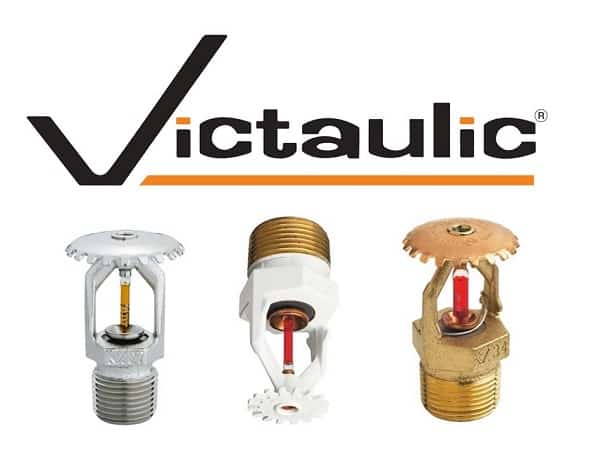Commercial fire sprinkler heads from Victaulic—convenient selection, international approval
A lot of people know Victaulic for its pipe-joining technology. The company’s founder, the former Lieutenant Ernest Tribe of Britain’s Royal Engineers, got his start joining pipe while working on flamethrowers in World War I. In 1919, Tribe patented the grooved coupling for which his company would later become famous. Victory Pipe Joint Co. (later changed to Victaulic, a mash-up of “Victory” and “Hydraulics”) followed shortly. The grooved coupling later helped the Allies efficiently move water and fuel to the front during World War II.
Despite its ironic start in flamethrower engineering, Victaulic is now a global leader in fire protection manufacturing, including fire sprinklers.
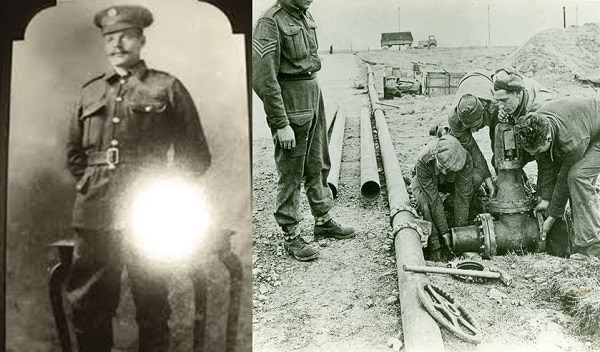
With so many sprinklers on the market, it’s easy to be overwhelmed by the sheer number of variables and choices. As part of our continuing series on the offerings of major fire sprinkler manufacturers, we’re taking a look at Victaulic’s commercial fire sprinkler selection and features.
First, we run through the features available in Victaulic’s commercial sprinkler line. Then, we provide handy tables to help you find the exact sprinkler you need for your application.
Keep reading to learn:
The key takeaway for sprinkler shoppers is that Victaulic’s selection is accessible and uncomplicated, and their sprinklers have approvals in jurisdictions across the globe. The company makes it easy to find the sprinkler you need wherever you are in the world.
Shop Victaulic’s commercial fire sprinklers on our website. We stock a wide range of upright, pendent, concealed pendent, and sidewall models in both quick and standard response. If you require a model that is not in our online inventory, simply call us at +1 (888) 361-6662 or email support@qrfs.com.
The core features of Victaulic sprinkler heads
As mentioned, there are two big reasons to choose Victaulic over any other sprinkler manufacturer. First, they don’t overwhelm you with choices. When many sprinkler lists can run into the hundreds, sometimes less is more. With Victaulic, finding the right sprinkler head is easy if you know the basic specs you need. If you require a standard coverage, standard response upright sprinkler, you have four part numbers to choose from.
Second, Victaulic is an international company. Whether you’re in the USA, Canada, the EU, China, or elsewhere, they likely have sprinkler heads tested and approved by organizations in your jurisdiction.
But let’s get down to brass tacks: Exactly what specs and features do they offer? Let’s run through Victaulic’s options in the following categories:
- Orientation
- Response speed and coverage area
- Response temperature
- K-factor and thread size
- Finish
- Approvals
The easiest way to refer to sprinklers is by their sprinkler identification number, or SIN. The main rule is that uniquely constructed sprinklers get unique SIN numbers. When the orientation, thread size, K-factor, or response speed changes in a sprinkler, something has to be shaped or sized differently. That means a new SIN number is usually assigned. For different finishes or temperature responses, however, new SINs are not needed.
Victaulic sprinkler orientation
Victaulic offers the four sprinkler orientations—pendent, concealed pendent, upright, and sidewall. Within these standard types, the company also provides two additional interesting variations—“old-style” or conventional upright sprinklers, and European pendent sprinklers.
Conventional sprinkler heads, referred by the National Fire Protection Association (NFPA) as “old-style,” are sprinkler heads of a type manufactured prior to 1953. They have an upright orientation and direct about 40% of their water upwards. They are now made and sold only as replacements for other conventional sprinkler heads. Victaulic also produces a few “European pendent” sprinklers manufactured to European standards and sold mainly on that continent.
Sprinkler activation temperature
Fire sprinklers spray water when a heat-sensitive element releases the pip cap sealing the orifice. For most sprinklers, this heat-sensitive element is a glass bulb filled with a thermosensitive liquid. When the liquid reaches a certain temperature, it expands, breaking the bulb and releasing the water. Others employ fusible metal links with a solder that melts.
Different applications need sprinklers to activate at different temperatures. Victaulic’s commercial sprinklers are available in the following temperature ratings:
- 135°F (57°C)
- 155°F (68°C)
- 175°F (79°C)
- 200°F (93°C)
- 286°F (141°C)
- 360°F (182°C)
Most sprinklers are available in all these temperatures. The main exceptions are quick response sprinklers, which are not rated for 360°F, and recessed and concealed pendent sprinklers, which are not rated for 286°F or above.
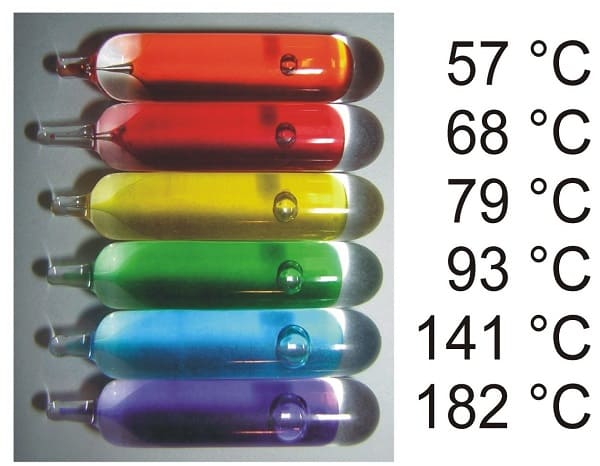
Sprinkler response
For every orientation, thread size, and K-factor option Victaulic offers, the company offers a choice between standard response (SR) and quick response (QR) sprinklers. Standard response sprinklers have broad applicability. They wet the area around a fire, depriving it of fuel and preventing its spread. Quick response sprinklers, common in light-hazard occupancies, have a smaller-than-usual glass bulb that causes them to activate earlier than standard response sprinklers. Their primary mission is to protect life and enable escape by suppressing temperatures and preventing flashover (the ignition of gasses released by a fire).
Different situations require different sprinklers. Despite the name, standard response sprinklers are not necessarily the default; Victaulic generally manufacturers a quick-response counterpart to every standard-response model. Then again, a quick response sprinkler isn’t always the best choice (or an allowable one, in specific settings). For instance, quick response and ultra-high-temperature sprinklers are often mutually exclusive; Victaulic’s quick response models cannot be purchased with a temperature rating of 360°F (182°C).
Sprinkler coverage
Just as there are options for how quickly a sprinkler activates, there are options for how much space a sprinkler can protect—standard coverage (SC) and extended coverage (EC). Standard coverage sprinklers can be placed up to 15 feet apart (or 12, in more hazardous occupancies). The alternative to standard coverage is extended coverage. Extended coverage sprinklers, simply put, cover a larger area (around 20 feet between sprinklers) than standard coverage sprinklers. This can allow designers to use fewer sprinklers, saving money.
However, extended coverage sprinklers come with special pressure and installation requirements and are not allowed by code everywhere. For this reason, Victaulic manufactures only a few EC sprinklers, and those are only approved by UL and FM Global for specific applications.
K-factor and thread size
A core parameter in fire sprinkler design, K-factor, determines how much water can be pushed through a sprinkler orifice at a given pressure. A big K-factor means a bigger orifice. Victaulic manufactures sprinklers with the following K-factors:
- 8 (4.0)
- 2 (6.1)
- 6 (8.1)
- 8 (11.5)
- 2 (16.1)
- 14 (20.2)
The highest two K-factors (11.2 and 14) are only used for extended-coverage sprinklers.
Sprinkler thread size (here we’ll use nominal measurements) roughly follows K-factor; a big orifice needs to connect to bigger pipe. Victaulic has 3/8 in. (10 mm), 1/2 in. (15 mm), and 3/4 in. (20 mm) threads available. For K= 8 or above, 3/4 in. threads are used. For K=5.6, 1/2 in. threads are used.
Victaulic sprinkler finishes
A sprinkler’s finish helps it fit with the aesthetics of a room. But beyond that, some finishes provide critical corrosion-resistance, extending the useful lifespan of sprinklers in challenging environments. Victaulic manufactures sprinklers with plain brass, chrome plating, white paint, black paint, a nickel-PTFE coating, and their proprietary VC-250 coating.
White paint, black paint, nickel-PTFE, and VC-250 are all tested and listed under the rigorous corrosion-resistance requirements of UL 199: Standard for Automatic Sprinklers for Fire-Protection Service.
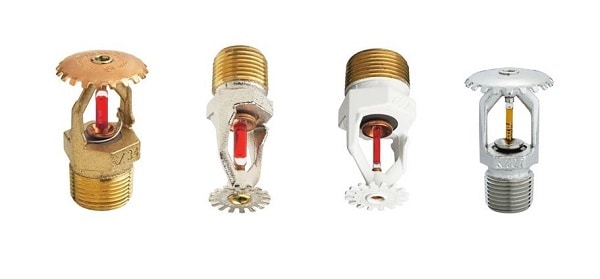
Approvals
In fire protection, most equipment must be approved by a qualified and designated testing laboratory. In North America, the UL mark (“cULus” in Canada) and approval by FM Global are the gold standards.
Victaulic is an international company, however, and it shows. Many of its technical documents are available in 13 different languages. Beyond that, Victaulic makes sure its products are approved by testing and certifying organizations around the world. Over half of the company’s standard coverage sprinklers carry marks from at least one organization outside the US and Canada, including:
- LPCB, the Loss Prevention Certification Board, is recognized globally, especially in the Asia-Pacific region, the Middle East, and Europe.
- VdS, a German certification agency belonging to the German Insurance Association.
- CE, a mark indicating that a product meets the health, safety, and environmental requirements of the European Economic Area (EEA) single market.
- CCCF, the China Compulsory Certification for Fire Safety Products, is required for sprinklers sold or used in China.
- CNBOP-PIB is the Polish Scientific and Research Centre for Fire Protection.
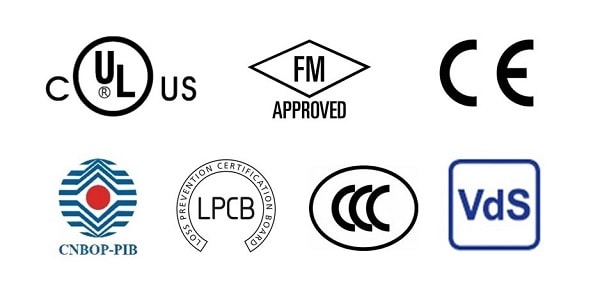
Choosing the right Victaulic fire sprinkler is easy
When it comes down to it, getting the right Victaulic sprinkler is simple. The company’s catalog makes it easy to find a sprinkler that fits your requirements. Start with choosing the orientation and then find the K-factor, coverage, and response that suit your project. From there, the choice should be clear.
We’ve compiled these tables to help you find the sprinkler you need. Shop Victaulic commercial sprinklers on our site, and reach out to us if you can’t find the exact part or with any questions.
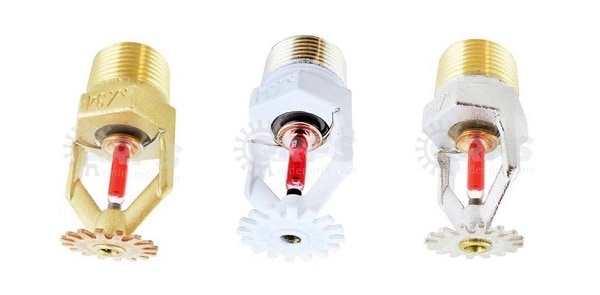
Victaulic Commercial Pendent Sprinklers
| SIN |
K-Factor
Imperial (SI)
|
Hazard | Coverage | Response |
Thread Size
In. (mm)
|
Approvals |
Max Pressure
PSI (bar)
|
|---|---|---|---|---|---|---|---|
Pendent Sprinklers |
|||||||
| V2403 | 4.2 (6.1) | LH | SC | SR | 3/8 (10) | cULus | 175 (12) |
| V2404 | 4.2 (6.1) | LH | SC | QR | 3/8 (10) | cULus | 175 (12) |
| V2705 | 2.8 (4.0) | LH | SC | SR | 1/2 (15) | cULus | 175 (12) |
| V2706 | 2.8 (4.0) | LH | SC | QR | 1/2 (15) | cULus | 175 (12) |
| V2707 | 5.6 (8.1) | All | SC | SR | 1/2 (15) | cULus, FM, LPCB, CCCF | 250 (17) |
| V2708 | 5.6 (8.1) | All | SC | QR | 1/2 (15) | cULus, FM, CCCF | 250 (17) |
| V3405 | 8 (11.5) | All | SC | SR | 3/4 (20) | cULus, FM | 175 (12) |
| V3411 | 11.2 (16.1) | LH | EC | SR | 3/4 (20) | cULus, FM | 175 (12) |
| V3412 | 11.2 (16.1) | LH | EC | QR | 3/4 (20) | cULus, FM | 175 (12) |
| V3413 | 14 (20.2) | LH | EC | SR | 3/4 (20) | cULus, FM | 175 (12) |
| V3414 | 14 (20.2) | LH | EC | QR | 3/4 (20) | cULus, FM | 175 (12) |
| V3421 | 14 (20.2) | OH | EC | SR | 3/4 (20) | cULus | 175 (12) |
| V3428 | 8 (11.5) | LH | EC | QR | 3/4 (20) | cULus | 175 (12) |
Recessed Pendent Sprinklers |
|||||||
| V3406 | 8 (11.5) | All | SC | QR | 3/4 (20) | cULus, FM, CCCF | 175 (12) |
European Pendent Sprinklers |
|||||||
| V2727 | 5.6 (8.1) | All | SC | SR | 1/2 (15) | cULus, VdS, LPCB, CE | 175 (12) |
| V2728 | 5.6 (8.1) | All | SC | QR | 1/2 (15) | cULus, VdS, LPCB, CE | 175 (12) |
| V3423 | 8 (11.5) | All | SC | SR | 3/4 (20) | VdS, LPCB, CE | 175 (12) |
| V3424 | 8 (11.5) | All | SC | QR | 3/4 (20) | VdS, LPCB, CE | 175 (12) |
Concealed Pendent Sprinklers |
|||||||
| V3801 | 5.6 (8.1) | LH, OH | SC | SR | 1/2 (15) | cULus, LPCB, CE, CCCF | 175 (12) |
| V3802 | 5.6 (8.1) | LH, OH | SC | QR | 1/2 (15) | cULus, FM, LPCB, CE, CCCF | 175 (12) |
| V3807 | 5.6 (8.1) | LH, OH | SC | SR | 1/2 (15) | cULus | 300 (21) |
| V3808 | 5.6 (8.1) | LH, OH | SC | QR | 1/2 (15) | cULus | 300 (21) |
| V3102 | 8 (11.2) | LH | EC | QR | 3/4 (20) | cULus | 175 (12) |
| V3104 | 11.2 (16.1) | LH | EC | QR | 3/4 (20) | cULus | 175 (12) |
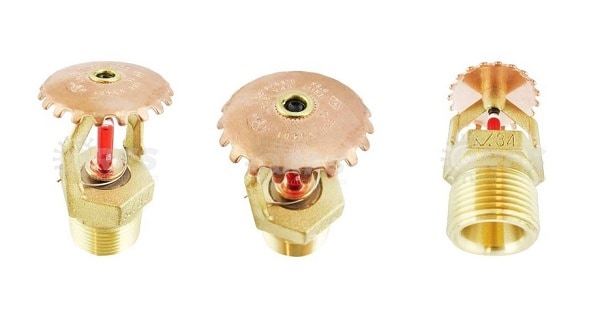
Victaulic Upright and Conventional Commercial Sprinklers
| SIN |
K-Factor
Imperial (SI)
|
Hazard | Coverage | Response |
Thread Size
In. (mm)
|
Approvals |
Max Pressure
PSI (bar)
|
|---|---|---|---|---|---|---|---|
Upright Sprinklers |
|||||||
| V2401 | 4.2 (6.1) | LH | SC | SR | 3/8 (10) | cULus | 175 (12) |
| V2402 | 4.2 (6.1) | LH | SC | QR | 3/8 (10) | cULus | 175 (12) |
| V2701 | 2.8 (4.0) | LH | SC | SR | 1/2 (15) | cULus, FM | 175 (12) |
| V2702 | 2.8 (4.0) | LH | SC | QR | 1/2 (15) | cULus, FM | 175 (12) |
| V2703 | 5.6 (8.1) | All | SC | SR | 1/2 (15) | cULus, FM, VdS, LPCB, CE, CCCF | 250 (17) |
| V2704 | 5.6 (8.1) | All | SC | QR | 1/2 (15) | cULus, FM, VdS, LPCB, CE, CCCF | 250 (17) |
| V3401 | 8 (11.5) | All | SC | SR | 3/4 (20) | cULus, FM, VdS, LPCB, CE | 175 (12) |
| V3402 | 8 (11.5) | All | SC | QR | 3/4 (20) | cULus, FM, VdS, LPCB, CE, CCCF | 175 (12) |
| V3425 | 14 (20.2) | OH | EC | SR | 3/4 (20) | cULus | 176 (12) |
Conventional Sprinklers |
|||||||
| V2725 | 5.6 (8.1) | OH | SC | SR | 1/2 (15) | cULus, VdS, LPCB, CE | 175 (12) |
| V2726 | 5.6 (8.1) | OH | SC | QR | 1/2 (15) | cULus, VdS, LPCB, CE | 175 (12) |
| V2753 | 5.6 (8.1) | All | SC | SR | 1/2 (15) | cULus | 300 (21) |
| V2754 | 5.6 (8.1) | All | SC | QR | 1/2 (15) | cULus | 300 (21) |
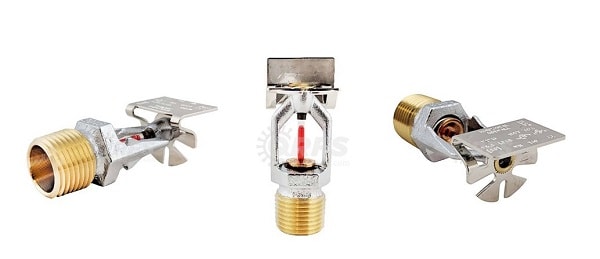
Victaulic Commercial Sidewall Sprinklers
| SIN |
K-Factor
Imperial (SI)
|
Hazard | Coverage | Response |
Thread Size
In. (mm)
|
Approvals |
Max Pressure
PSI (bar)
|
|---|---|---|---|---|---|---|---|
| V2709 | 5.6 (8.1) | LH, OH | SC | SR | 1/2 (15) | cULus, FM, LPCB, CE, CCCF | 250 (17) |
| V2710 | 5.6 (8.1) | LH, OH | SC | QR | 1/2 (15) | cULus, FM, LPCB, CE, CCCF | 250 (17) |
| V3409 | 8 (11.5) | LH, OH | SC | SR | 3/4 (20) | cULus | 175 (12) |
| V3410 | 8 (11.5) | LH, OH | SC | QR | 3/4 (20) | cULus | 175 (12) |
| V3415 | 8 (11.5) | LH | EC | SR | 3/4 (20) | cULus, FM | 175 (12) |
| V3416 | 8 (11.5) | LH | EC | QR | 3/4 (20) | cULus, FM | 175 (12) |
Again, don’t hesitate to call us at +1 (888) 361-6662 or email support@qrfs.com with questions or to get help finding a specific part number.
This blog was originally posted at blog.qrfs.com. If this article helped you, check us out at Facebook.com/QuickResponseFireSupply or on Twitter @QuickResponseFS.


